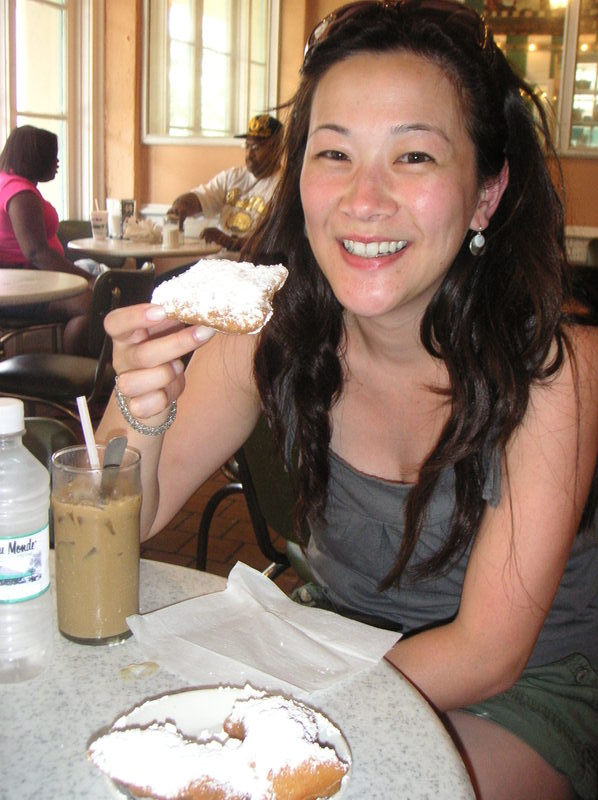Marley was born at 5am on July 18th! The ducks my father currently keeps have a great life under the big willow tree and share a pond edged in waterlilies and lotus flowers. The only thing more that they could ask for is perhaps more friends and a bigger family. There is a lot of information out there (a few links at bottom) about the proper incubation and care of eggs, and there are probably things my father didn't do quite right, but this is his second year and he has been very successful. Disclaimer: I am only going to regale you with our personal experiences.

Below is a closer pic of some of the ducks. You can also see his new Chinese geese. Look for the pair of white and the pair of brown geese. He just picked these new babies up from
CornerStone Farm in Red Oak, VA. The white geese are 2 years old and the brown about 6 months.

For a few days prior to the decided incubation day, my father gathered eggs he found in nests by the water and under the willow tree. The eggs were just stored in the garage until he gathered enough eggs to start. Here are the eggs in the incubator. It's a simple incubator. There's wire mesh on the bottom where the eggs sit, and he leaves little dishes under the wire with water to help with humidity. There's no automatic humidity control. There is a hole in the top with a peg in it that you take out or put in. There's a little knob for temperature control. He aims for the temperature to be at exactly 99 degrees F. Since there's no automatic thermostat, it's important to have a thermometer in the incubator and important to make adjustments. ***In fact, you should probably do this for at least several hours before you begin incubating***

You probably can't see in this photo above, but the eggs are marked A and B. This helps you with the turning of the eggs. One website said the eggs must be turned 4 times a day, but my father turned his eggs twice a day. It's simple. Take the cover off, and flip the A sides to the B sides. Marking them A and B just helps to ensure you don't miss an egg.
After a week or so, you can try candling to see how things are going, but when we tried this last year, we didn't see anything. Of course, we probably didn't know what we were doing! This year, we didn't even bother trying.
On day 25, 3 days prior to the expected day of arrival, my father stopped turning the eggs and just watched every day, checking the temperature regularly as usual.
On day 26, we noticed some some eggs had a spot where the soon to be hatched ducklings had started pecking.
We didn't have to try too hard to hear the little peeps!!! You'll be amazed to ponder the fact that very soon, you'll see the baby ducklings. Go ahead and cry. It's an amazing and emotional thing to witness! You will eventually see a hole pecked through and if you look closely, you'll see the duckling respirating inside. At this point, you should call everyone you know. Have your kids or grandkids spend the night because there will be lots of excitement in the next 24 hours.
Here are pictures of a duck hatching from it's shell. First you'll notice a little crack in the shell.
Below is how the same egg looks 40 minutes later. At this point, there is loud peeping and the egg rolls/moves slightly every now and again. If you could zoom in, you'd see the little egg tooth (to the right of the crack).
It stays like this, moving around a bit and peeping for another 45 minutes. Then, the next several photos show the duck hatching from it's shell. These pictures were taken within 10 minutes.
If you're hatching ducks with kids, be prepared to explain that it only LOOKS like it's dead because it's very, very poopered from all the hard work pushing out of it's shell. Within a few hours, it will dry off, and everyone will be suprised to see how hearty these newborns are.
Here are the first three ducklings. The fluffier, dry, dark colored one was born first (this is Marley!) and is about 11 hours old in this next picture. The other dark one was born next, the yellow one was born about an hour ago before this photo was taken. As the ducks mature, the dark ones will get darker, and the yellow will turn white.

As soon as a duckling is born, we move it to the cardboard box. There is water in a dish and moistened "crumble" food in another little dish and they will start eating within about 24 hours. You'll see a heat lamp and thermometer to assure they are kept warm. Within a few hours, they'll also start spashing around in the water.

Look how many more were hatched within the following 24 hours!!

Marley is one of the 16 duckings you see in the photo above. If you're oohing and aahing, please realize how easy it was to experience the wonder of hatching ducklings. There are plenty of jobs for kids, lessons to be learned, and lots for kids to observe.
This blogger in Orange County shares how her kids were involved. Probably a great homeschooling lesson as well. I think it'd be fantastic in a kindergarten classroom, but for us, all the excitement happened between Friday night and Sunday night, not ideal if this were to happen while the class were home for the weekend. As I mentioned, this is just my account of how we incubated and hatched ducklings. I would not feel comfortable sending you out there with your eggs and incubator without further details and exact info, so try Cornell's Duck Research Laboratory's page on
Hatching Duck Eggs for all the directions on how to hatch ducks. Also,
here's a great You Tube video where you'll see a different type of incubator, and more importantly (and cutely), hear the little peeps of a newly hatched duckling!








































AWW! So cute.
ReplyDeleteThat last picture is the cutest I have ever seen! I love that they are in their water dish, how fun! I love your blog and the wall you built was superb, Good Job! I am off to find your blog on Blotanical~
ReplyDeleteHeather
smallgoatgarden
Thanks Heather! I am off to read your blog as well. Bought a book on canning and I think your blog will be really helpful. Plus, I'm excited to see your animals and garden.
ReplyDeleteWendy, that is amazing! It is so great you stuck around and saw those ducklings hatch! Wow! You are a great photographer (and writer and blog designer)! I have such a skilled friend :)
ReplyDeleteWendy, I just witness a whole 'life' show! I could watch the ducklings hatch from the eggs, thanks to your detailed photos. I agree that this is certainly a great learning experience for children. You post brought back a lot of memories to me when as a little kid, I helped my grandma raised chickens, ducks, turkeys and goose. I have never watched them hatch. We bought the little chicks and ducklings from the market and rear them. I remember how I couldn't sleep worrying over them whenever it rains heavily or when the weather got cold. It was also heartbreak moment when they are old enough to be slaughtered. These are beautiful moments children can share with their grandparents and remember for a long long time.
ReplyDeleteNot to mention the kids would enjoy it, even me ~ an adult who has never seen a hatching process ~ had a great time! Thanks for this sharing!
ReplyDelete